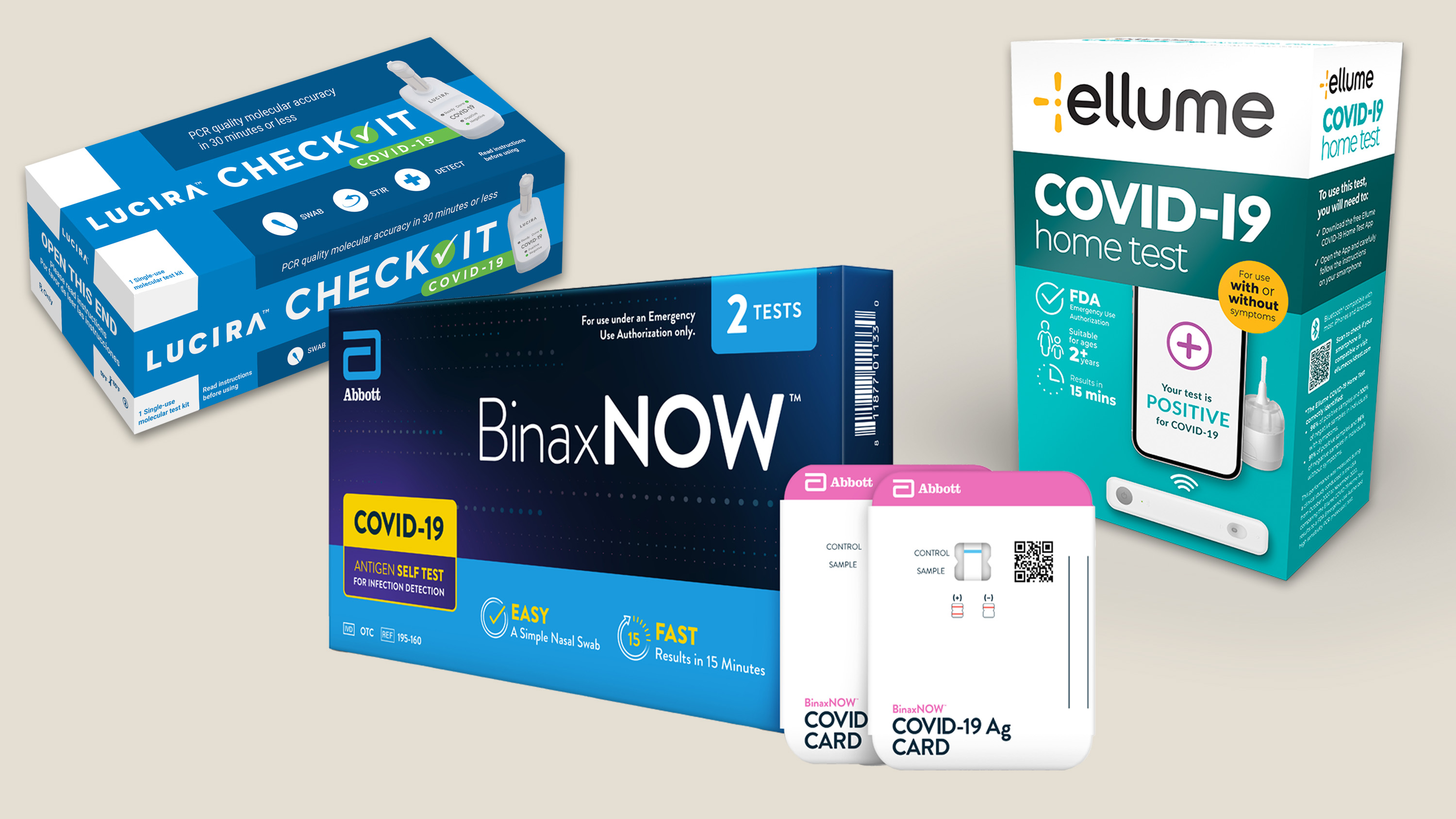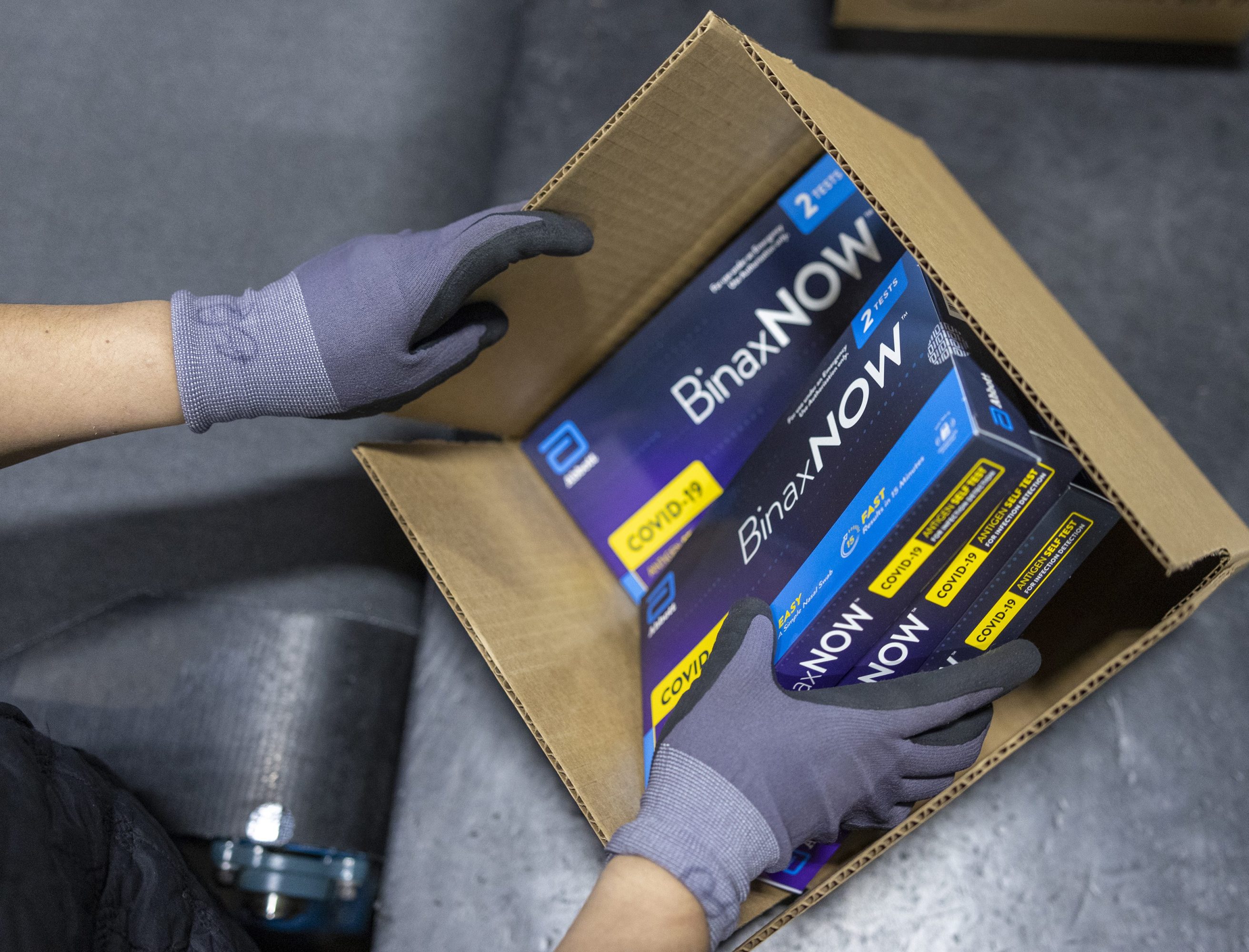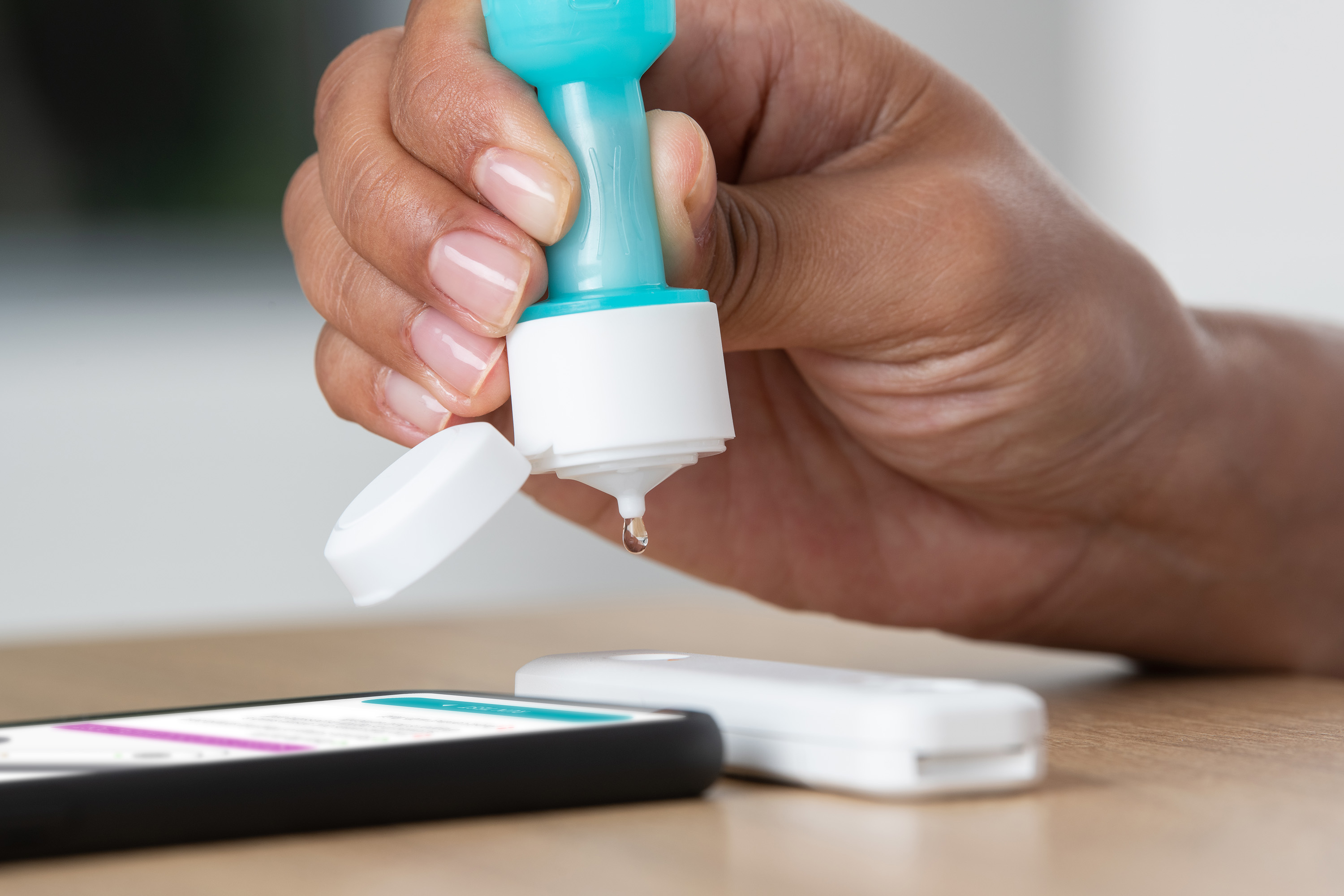We reviewed three at-home covid tests. The results were mixed.
Over-the-counter coronavirus tests are finally available in the US. Some are more accurate and easier to use than others.

Update, January 2022: This article discusses false positives from covid-19 home tests. Some recent scientific studies have found that rates of false positives can be several times less than those estimated by manufacturers. High levels of covid-19 in the community also greatly reduce the chance any positive test you get is a false positive. MIT Technology Review encourages you to use rapid tests if you can find one. In addition, the U.S. Food & Drug Administration says there is evidence rapid tests may have reduced ability to detect the omicron variant, meaning home tests would have a higher chance of a false negative, or not detecting covid-19 even though you have it. Read more on self-testing from the CDC here and from the FDA here.
Over-the-counter home tests for covid-19 are finally here. MIT Technology Review obtained kits sold by three companies and tried them out.
After buying tests from CVS and online, I tested myself several times and ended up learning an important lesson: while some people worry that home tests could miss covid cases, the bigger problem may be just the opposite. These tests have “false positive” rates of around 2%, which means that if you keep using them, you’ll eventually test positive, even though you don't have covid-19.
That happened to me. I tested negative several times, but the fourth time the result came up “POSITIVE FOR COVID-19.” I knew that was probably wrong—I’m a dedicated quarantiner who rarely goes anywhere. But I was sufficiently alarmed to follow the directions and scurry to a hospital for a gold-standard laboratory test, wasting my time and that of the friendly nurse who swabbed deep into my nasal cavity. That result was negative.
Some experts have argued that cheap, fast tests could be used to screen the whole population every week. But what I learned is that this type of mass screening could be as much of a public nuisance as pandemic-buster. In fact, if you tested everyone in the US tomorrow with over-the-counter tests, the large majority of positive results—maybe nine out of 10—would be false alarms.
After trying them, I do think there is an important role for consumer tests. Overall, I found they’re easy to use, cheaper than existing mail-in tests, and more convenient than waiting at a testing site. If you have symptoms, or fear you’ve been exposed, having a test handy could help. As a screening tool for schools or businesses, they could also work, so long as there’s a backup plan to confirm positives.
Accuracy issues
The issue with home tests is accuracy, which is between 85% and 95% for detecting covid. That is, they catch about nine of every 10 infections, a metric called the test’s “sensitivity.” Some people have said that any missed cases are a worry, since a person with a false negative could go out and infect someone else. But if the alternative is no test at all, then none of those infections would be caught.
The tricky part of unrestricted testing, I learned, comes instead from the concept of “specificity,” or the rate at which a test correctly identifies negatives. For the home tests I tried, that figure is about 98%, with a corresponding 2% rate of false positives. What I didn’t realize—and what your everyday CVS shopper won’t either—is that there are two ways that less-than-perfect specificity can get amplified into a bigger problem.
The first way is through repeat testing, the kind I did. By the time my review of the home tests was complete, I’d tested five times in two days, accumulating 1 in 10 odds of being told I had covid when I didn’t (a 2% chance of a false positive each time, multiplied by five tests). The second source of trouble I didn’t anticipate is what is known as “pretest probability.” As I said, I don’t socialize, so my probability of actually having covid in first place was very low, maybe even zero. What this meant is that my chance of a correct positive when I took the test was also essentially zero, while my false positive chance remained 2% like everyone else’s. The way I was using the test, any positive result was nearly certain to be wrong.
Now consider this same phenomenon—a higher chance of false positives than of real ones—applying to a large group, or even a whole country. In the US, covid rates are falling. This lower background rate means if home tests were used by everyone in the country tomorrow, there could be five to 15 wrong positives for every right one.
As a result, I don’t think home tests are as useful as some have hoped. If used at scale to screen for covid, they could send millions of anxious people in search of lab tests and medical care they don’t need.
Still relevant?
As the covid-19 pandemic spread around the globe last year, economists and scientists called for massive expansion of testing and contact tracing in the US, to find and isolate infected people. But the number of daily tests in the US has never much exceeded 2 million, according to the Covid Tracking Project, and most of those were done in labs or on special instruments.
Home tests will now be manufactured in the tens of millions, say their makers, but some experts aren’t sure how much they will matter at this point. “The real value of these tests was six months ago,” says Amitabh Chandra, a professor at Harvard University’s Kennedy School. “I think that the move to over-the-counter is great, but it has limited value in a world where vaccines become more widely available.” Vaccination credentials could be more important for travel and dining than test results are.
Companies selling the tests say they are still a relevant strategy for getting back to normal, especially given that kids aren’t getting vaccinated yet. For employers who want to keep an office or factory open, they say, self-directed consumer tests might be a good option. A spokesperson for Abbott told me that they might also help people “start thinking about coordinating more covid-conscious bridal showers, baby showers, or birthday parties.”
The UK government started giving away covid antigen tests for free, by mail and on street corners, on April 9, saying it wants people “to get in the habit” of testing themselves twice a week as social distancing restrictions are eased. Along with vaccines, free tests are part of that nation’s plan to quash the virus. Later, though, a leaked government memo said health officials were privately worried about a tsunami of false positives.
In the US, there’s no still no national campaign around home tests or subsidy for them, and as an out-of-pocket expense, they are still too expensive for most people to use with any frequency. That may be for the best, given my experience.
Types of tests
The three tests we tried included two antigen tests, BinaxNow from Abbott Laboratories and a kit from Ellume, as well as one molecular test, called Lucira. In general, molecular tests, which detect the genes of the coronavirus, are more reliable than antigen tests, which sense the presence of the virus’s outer shell.
Everything you need is in one box, except in the case of the Ellume test, which must be paired with an app. Overall, the Lucira test had the best combination of advertised accuracy and simplicity, but it was also the most expensive at $55.
We didn’t try Quidel QuickVue, another antigen test, or a molecular test from Cue Health. Those tests, while authorized for home use, are not being sold directly to the public yet.
After trying all the tests, I am not planning to invest in using them regularly. I work from home and don’t socialize, so I don’t really need to. Instead, I plan to keep at least one test in my cupboard so that if I do feel sick, or lose my sense of smell, I will be able to quickly find out whether it’s covid-19. The ability to test at home might become more important next winter when cold and flu season returns.

BinaxNow by Abbott
Time required: about 20 minutes
Price: $23.99 for two
Availability: At some CVS stores starting in April. Abbott says it is making tens of millions of BinaxNow tests per month.
Accuracy: 84.6% for detecting covid-19 infections, 98.5% for correctly identifying covid-19 negatives
This is the at-home version of the fast, 15-minute test the White House was using last year to screen staff and visitors. It’s an antigen test, meaning that it examines a sample from a nasal swab to detect a protein in the shell of the virus. It went on sale in the US last week, and I was able to buy a two-test kit at CVS for $23.99 plus tax.
The technology used is called a “lateral flow immunoassay.” In simple terms, that means it works like a pregnancy test. It’s basically a paper card with a test strip. As the sample flows through it, it hits antibodies that stick to the virus protein and then to a colored marker. If the virus is present, a pink bar appears on the strip.
I found the test fairly easy to perform. You use an eye dropper to dispense six drops of chemical into a small hole in the card; then you insert a swab after you’ve run it around in both nostrils. Rotate the swab counterclockwise, fold the card to bring the test strip in contact with the swab, and that’s it. Fifteen minutes later, a positive result will show up as a faint pink line.
The drawback of the test is that there’s room for two different kinds of user error. It’s hard to see the drops come out of the dropper, and using too few could cause a false negative. So could swabbing your nose incorrectly. Unlike the other tests, this one can’t tell if you’ve made a mistake.
And besides the prospect of user error, the test itself has issues with accuracy. BinaxNow is the cheapest test out there, but it’s also the most likely to be wrong, missing about one in seven real infections. Abbott cautions that results “should be treated as presumptive” and “do not rule out SARS-Cov-2.”
But a buyer won’t find the accuracy rate without digging into the fine print. The company also buries a crucial requirement imposed by regulators: to compensate for the lower accuracy, you are supposed to use both tests in the kit, at least 36 hours apart. I doubt a casual buyer will realize that. The two-test requirement is barely mentioned in the instructions.
Lucira Check-It
Time required: about 40 minutes
Price: $55
Availability: Can be purchased online at lucirahealth.com
Accuracy: 94% for positives, 98% for negatives
Of all the kits I used, Lucira was far and away my favorite. This is a laboratory-type test, with techniques similar to those used by professional labs, and you feel a little bit like a scientist using it.
Since it’s not in stores yet, the Lucira test needs to be ordered online, and I would suggest doing so well before you need it. The first test I purchased took five days to arrive, leaving me anxious about its whereabouts. The company says you can track its packages, but I wasn’t able to access any tracking data until after my kit arrived. I ordered a second test, this time paying $20 for express shipping, and I still couldn’t find the tracking information.
At $55, this is the most expensive test we reviewed, so it’s not something you’ll use too often. Still, it’s about half the cost of the mail-away swab tests from companies like Vault Health—previously my go-to option for avoiding hospitals and crowded testing facilities, as when I needed to test my kid last July so she could go to sleep-away camp. Those mail-in tests give an answer within 48 hours. With Lucira, you’ll get your answer in under an hour.
The test kit includes a swab, a tube of purple chemicals, and a small battery-operated base station. It works with a technology called LAMP, a molecular method that makes copies of a coronavirus gene until the amount is large enough to detect. That means it’s nearly equivalent to PCR, the gold-standard test used by labs. Unlike PCR, a test using LAMP doesn’t need rapid heating and cooling, so it can be run at home.
After swabbing your nose, you stir the swab in the tube and then then click it into place in the base station. After half an hour, one of two LED lights turns on, saying either “Positive” or “Negative.” I found the Lucira test’s readout the easiest to understand.

Ellume Home Covid Test
Time required: about 45 minutes
Price: $38.99
Availability: Available online at CVS.com The company says it is shipping 100,000 tests a day to the US from Australia and will be manufacturing 500,000 tests a day in the US by the end of the year.
Accuracy: 95% for positives, 97% for negatives
Home tests still aren’t easy to find, and I couldn't find a pharmacy that stocked Ellume, a test marketed by an Australian company of the same name. But the company had previously sent me a sample kit, which I used in this review. As of this week, the Ellume test can also be purchased through the website of CVS.
Of all the tests I tried, Ellume’s had the most components—five, versus three for the others. That tally included an app that you have to download onto your phone. Including resetting your Apple ID if you forget it, as I always do, and answering the app’s questions, including your name, address, and phone number, plus a break to get a cup of coffee, this test took longer to carry out. Budget an hour if you decide to read the app’s privacy policy and terms and conditions.
Like the Abbott test, Ellume’s is an antigen test. But it is a more sophisticated one, with embedded optics and electronics that read a fluorescent result. In addition to looking for the virus, it also detects a common human protein, so if you didn’t swab you nose correctly, the test will know.
Thanks to these bells and whistles, and a special swab, Ellume has a higher accuracy rate for spotting covid than other antigen tests, missing only one in 20 infections, according to the company. The drawback is that it is 50% more likely than other tests to falsely inform you that you are positive for covid-19 when you are not. Indeed, my false positive result occurred while using this test.
Because it uses a phone app, you’ll need an internet connection to use Ellume, which involves communication between your phone and the kit via Bluetooth. An advantage of the app is that it provides good directions and an electronic receipt for your test—the kind you can show to a school or employer. The others I tried didn’t have a paper trail, so there’s no proof you took the test. But that receipt comes with a privacy cost. Of the three tests I tried, Ellume’s was the only one that isn’t entirely private. The app warns that it will share “certain information with public health authorities.” That information turns out to include your birthday, your zip code, and your test result. The company says the data helps health agencies track the pandemic and report infection levels.
Deep Dive
Biotechnology and health
How scientists traced a mysterious covid case back to six toilets
When wastewater surveillance turns into a hunt for a single infected individual, the ethics get tricky.
An AI-driven “factory of drugs” claims to have hit a big milestone
Insilico is part of a wave of companies betting on AI as the "next amazing revolution" in biology
The quest to legitimize longevity medicine
Longevity clinics offer a mix of services that largely cater to the wealthy. Now there’s a push to establish their work as a credible medical field.
There is a new most expensive drug in the world. Price tag: $4.25 million
But will the latest gene therapy suffer the curse of the costliest drug?
Stay connected
Get the latest updates from
MIT Technology Review
Discover special offers, top stories, upcoming events, and more.